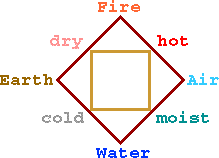

The Greeks were the first to propose physical explanations for materials. Thales (of Miletos 624-546 B.C.) developed a Babalonian idea that the world was created from the waters. He suggested that every substance is but a single reality, water, but appearing in different forms. Water exhibits all the known states of matter, solid, liquid, and gaseous, and is clearly essential to life as well.
Anaximandros (of Miletos 610 to 545 B.C.) agreed with Thales that the world is made of some basic element. But Anaximandros thought that element was some undetermined material: apeiron.
Anaximenes (of Miletos about 590 to 526 B.C.) claimed that air (pneuma) is the elemental material. Variety of substance is due to thickening or thinning.
Heracleitos (flourishing in Ephesos in 484 B.C.) suggested everything consists of fire or some other single material and that is changed by eternal flux (then meaning up and down motion
).
Anaxagoras (of Clazomenae perhaps 500 to 428 B.C.) suggested the world is essentially complex and divisible seeds controlled by mind (Nus) The component seeds of everything are the same nature as the thing itself.
 Empedocles (of Agrigentum 492 to about 400 B.C.) combined aspects of the previous ideas. Empedocles suggested that everythings consists of four elements: Fire, air, water, and earth, and two forces: love (attraction) and strife (repulsion). (Fire and the other elements were thought to be related to what we observe, but more pure.)
Empedocles (of Agrigentum 492 to about 400 B.C.) combined aspects of the previous ideas. Empedocles suggested that everythings consists of four elements: Fire, air, water, and earth, and two forces: love (attraction) and strife (repulsion). (Fire and the other elements were thought to be related to what we observe, but more pure.)
Aristotle (of Stageira 384 to 322 B.C.) compiled a consistent account of all knowledge. Aristotle included Empedocles four elements of the world (Fire, air, water, and earth), but added a fifth element (æther) to account for the material of heavenly objects.
Unlike his teacher Plato, Aristotle believed that truth is found by observing the universe. This became one of the tenants of science. Aristotle was primarily an encyclopedist. While earlier philosophers had also tried to explain the universe, Aristotle was the first to realize it was first necessary toinventory and describe.Generalizations are derived from the observation of many examples. Aristotle invented the rules of logic, a process necessary for science!Aristotle tutored Alexander (the Great), who widely spread Aristotle's teachings. As a result, Aristotle's teachings, including the four earthly elements, remained accepted until the 18th Century!
Nearly a century earlier, Leucippos (perhaps born about 450 B.C. in Miletos) proposed an idea of materials that Aristotle found inconsistent with the concept of five elements. Leucippos suggested that the universe is composed of an infinite variety of small particles. The idea of Leucippos was developed by Democritos (born about 420 B.C. in Abdera) who studied with the learned men during his extensive travels. Democritos claiming substances of the world are divided into small particles called atoms. The atoms are infinite in number, indivisible, indestructible, and absolutely simple. Observed changes are due to continual aggregation and disaggregation of atoms in an infinity of ways. The empty space between atoms is void.
The comprehensive explanations of Democritos could explain most known facts. However Aristotle adopted the conflicting ideas of Empedocles which because of Alexander's influence, became the accepted explanation of materials for the next 2000 years. None of the Greek explanations could be tested, one of the modern criteria of science. Thus none of the Greek explanations are regarded as scientific hypotheses.


| introduction | ↑ | alchemy | Lavoisier | Dalton | Berzelius | molecules | spectra | electron | radiation | Bohr | isotopes | synthesis |
| to site menu | Discovery and Naming of Chemical Elements |
chemistry | physics | |||||||||
| created 19 March 2002, additions 6 April latest revision 4 November 2006 |
by D Trapp | |||||||||||